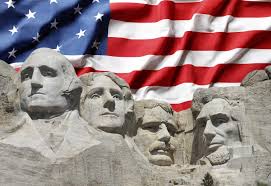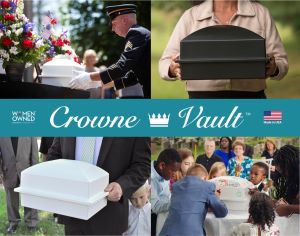The Lincoln funeral train. . . Did that ceremony lead to American funeral homes?
 Next Monday residents of the United States will celebrate President’s Day. Just so you know, when I was young, and until changed by the Uniform Monday Holiday Act of 1971, this day was known as Washington’s Birthday holiday since 1879 and celebrated on President George Washington’s birthday, February 22. When I was young, many states also celebrated the birthday of President Abraham Lincoln each February 12.
Next Monday residents of the United States will celebrate President’s Day. Just so you know, when I was young, and until changed by the Uniform Monday Holiday Act of 1971, this day was known as Washington’s Birthday holiday since 1879 and celebrated on President George Washington’s birthday, February 22. When I was young, many states also celebrated the birthday of President Abraham Lincoln each February 12.
An early draft of the Uniform Monday Holiday Act would have renamed the holiday “Presidents’ Day” to honor the birthdays of both Washington and Lincoln, which would explain why the chosen date falls between the two, but this proposal failed in committee, and the bill was voted on and signed into law on June 28, 1968, keeping the name “Washington’s Birthday”.
Then, however, On February 21, 1971, President Richard Nixon issued a proclamation naming the holiday “President’s Day” and calling it “the first such three-day holiday set aside to honor all presidents, even myself.”
So, that is somewhat of a long introduction into this article about the post-mortem care and ceremony of President Abraham Lincoln in 1865. As you know, Lincoln, a native of Illinois, died from an assassin’s bullet on April 15, 1865, while serving as the 16th President of the United States. Lincon’s widow decided that he should be entombed in Springfield, Illinois — some 1700 miles from Washington, DC, and a train would take the deceased president there.
Secretary of War Edwin Stanton believed that United States citizens needed a chance to say “good-bye” to the President and it was decided that the train would re-trace in reverse the trip that then President-elect Lincoln took on his way from Springfield, Illinois, to his inauguration in Washington, DC. The “Funeral Train” left the Baltimore and Union station on April 21 and arrived in Springfield, Illinois, on May 3. The train went through Philadelphia and New York City before turning westward.
The train passed through 400 communities and in 10 of those communities was stopped and Lincoln’s casket was taken off the train and opened for public visitations. This article from the History Channel estimates that over 1 million people actually paid respects by filing by the casket.
Part of what made this all possible was the advances in embalming that was greatly enhanced during the Civil War. . . in part to make sure those young men who died in distance states could be transported home for burials. Here is an excerpt from the History Channel article:
“Lincoln’s widow, who was too distraught to leave the White House for five weeks, was not among the funeral train’s 150 passengers, who included a funeral director and an embalmer. Wishing to give Americans a chance to see their fallen president face-to-face one final time, Stanton had gained Mary Lincoln’s consent to allow the lifting of the upper half of the casket lid for public viewings in 10 cities along the route.
The great advances in the art of embalming during the Civil War had allowed the unrefrigerated bodies of tens of thousands of soldiers to be returned to their families for burial, and the same process was used to preserve the commander-in-chief. Embalmer Charles Brown proclaimed there would be no perceptible change in Lincoln’s appearance by the end of the lengthy tour. “The body of the president will never know decay,” he assured the Chicago Tribune.”
Funeral Director Daily take: When you see the year of death and the funeral train ceremony – 1865 – you realize that is about the same year some of American’s oldest funeral homes were established. Up until that time there were undertakers who took care of dressing bodies and laying them out in the homes for mourning, but it was rare to see specific buildings or businesses set aside to operate the ceremonies of what we now consider funerals.

Tom Anderson
Funeral Director Daily
For instance, our family funeral home in Minnesota traces its roots back to my great-grandfather’s cabinet shop established in 1872. He was contracted to build caskets for residents beginning at that time but we did not move into a building built for funerals until the 20th century. By the way, our family operated that business with only family member owners until 2013 and I still own a small percentage as we celebrate our 150th year in business in 2022.
I’ve often wondered how the Lincoln funeral ceremony, including the on-going visitations on the way home to Springfield, Illinois, influenced the creation and boom in American funeral homes and funeral directors. I like to think that it is “more than coincidence” that so many funeral homes sprung up in communities all over the country at this time.
Finally, in conjunction of the President’s Day Holiday I researched George Washington’s death and funeral. Here’s an article on such which states that his funeral was held at Mount Vernon – his home – after a three-day period of mourning where his body did not leave his home. And, as you may know, he is entombed on the Mount Vernon property to this day.
I’ve toured Mount Vernon and it is kept in the same historical perspective as when he and his wife, Martha, lived there. Standing in the entry way, I envisioned him coming home during the Revolutionary War, walking, in and knocking the snow off his boots before saying hello to his family. It’s a “goosebump” feeling to be standing in that historical of a place.
We were shown the room on the 2nd floor where he died. When walking back down the steps I found myself thinking, “How did they get him (and the cot) down this tight curving stairway.” I smiled to myself and thought, “Only a funeral director would have that thought in this solemn place.”
More news from the world of Death Care:
- Ancient Egyptian embalming materials unearthed near Cairo. Mena
- Outlook: Buying a monument pre-need has many advantages. The Herald (PA)
- Sydney funeral director’s license revoked after wrong body cremated. CBC News (Canada)
Enter your e-mail below to join the 2,551 others who receive Funeral Director Daily articles daily:






















Thought you might also find this article interesting – it details how President Ulyssess Grant’s funeral flowers have been stayed preserved for 136 years: https://www.atlasobscura.com/articles/president-grant-memorial-flowers